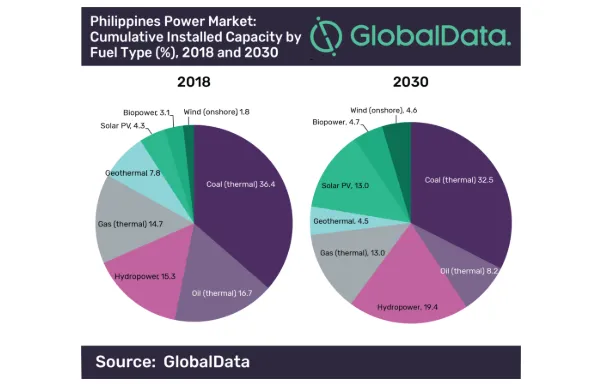
Philippines' non-hydro renewable power capacity to grow 11.2% by 2030
Its non-hydro renewable power capacity accounted for 16.9% of its total energy mix, led by geothermal.
The Philippines’ installed non-hydro renewable power capacity is expected to register a compound annual growth rate (CAGR) of 11.2% between 2018 and 2030 with support from the government, according to data and analytics company GlobalData’s latest market report.
The report, which focused on market trends, regulations and the competitive landscape in the Philippines, revealed that the growing economy has led to an increase in electricity consumption, which is expected to increase at a CAGR of 6.5%, from 81.7TWh in 2018 to 173.9TWh in 2030.
The firm noted that the country’s industrial and residential sectors have been the largest in terms of electricity consumption. That said, the rapid growth in consumption may cause demand to outstrip supply, despite how the capacity from the ongoing and planned power projects is forecasted to increase.
“Growing population is driving electricity consumption in the Philippines. As a result, new investment in capacity addition is urgently needed,” Harshavardhan Reddy Nagatham, power industry analyst at GlobalData, explained. “Peak demand has been increasing annually and a lot of new operational capacity is expected to be unlocked in the near future.”
One of the major avenues of investment is expected to be in the field of renewable energy, GlobalData also revealed.
Also read: Philippine utilities boost gas and renewables' share in energy mix
“In order to reduce its dependence on imported fossil fuels, the Philippine government is promoting the development of renewable power capacity. Net-metering of rooftop solar installations is also being bolstered,” the firm explained.
As of 2018, coal-fired thermal power dominated the Philippines’ power portfolio with a share of 36.4% of the total installed capacity, followed by oil-fired thermal, hydro, and gas-fired thermal power in that order. Non-hydro renewable power capacity accounted for 16.9% of all capacity, with geothermal power accounting for the most.
The government is promoting the capacity addition of solar, wind and bio-power capacity through Feed-in Tariffs (FiTs).
Meanwhile, the share of thermal power in the total installed capacity is set to decline from 67.8% in 2018 to 53.7% in 2030, which is expected to be compensated by an increase in non-hydro renewable energy sources with their share expected to increase from the current 16.9% to 26.9% in 2030.
“Net-metering currently has low adoption in the Philippines, but can play a major role in increasing renewable power capacity in the country and in helping with the supply security,” Nagatham explained. “Creating awareness amongst the public and businesses to embrace the technology and encouraging the adoption of solar and other renewable power technologies amongst institutional power consumers will go a long way in achieving the country’s energy independence and security.”



















 Advertise
Advertise






